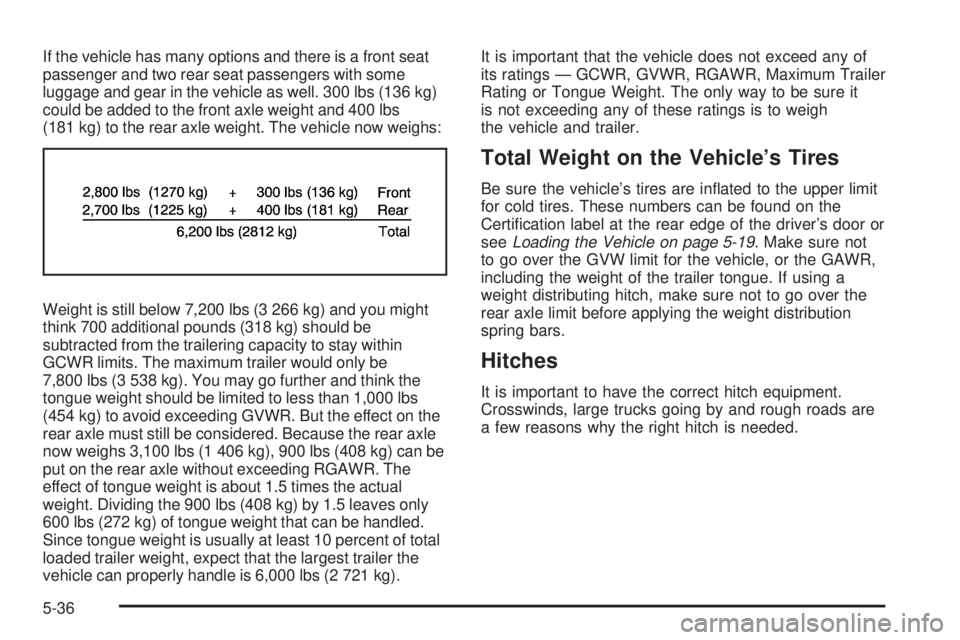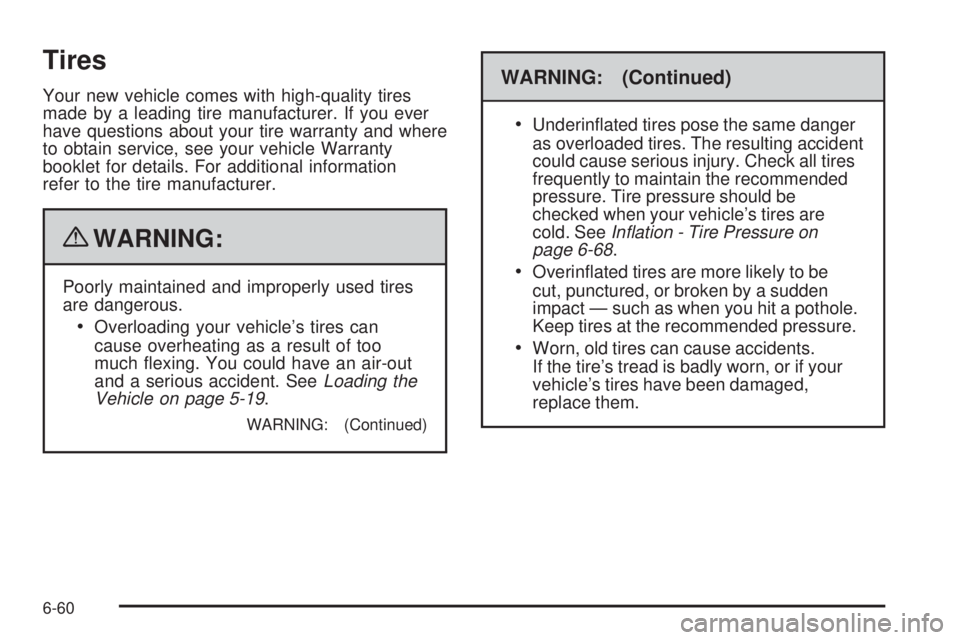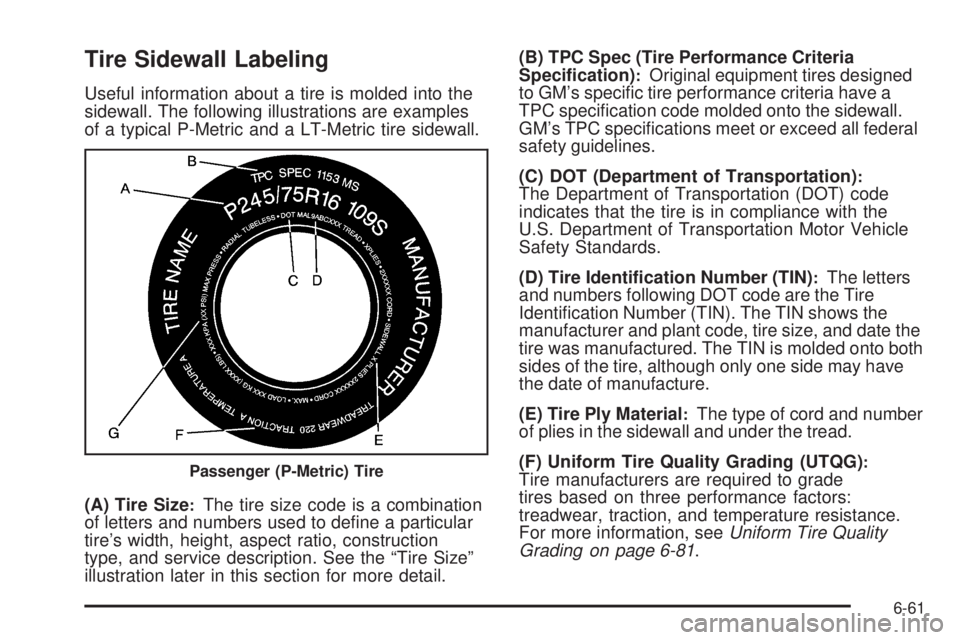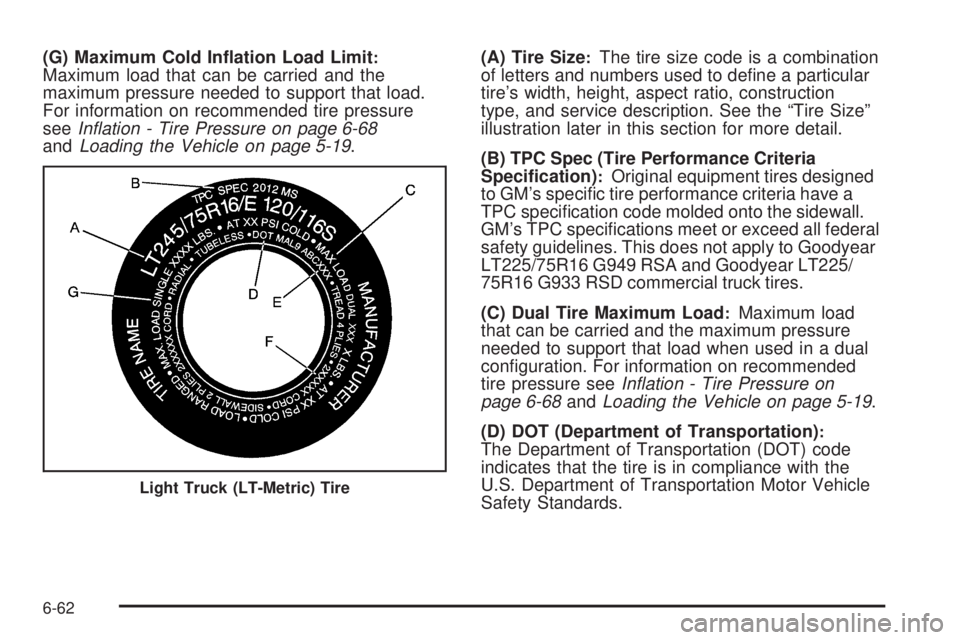2009 CHEVROLET EXPRESS tires
[x] Cancel search: tiresPage 259 of 440

Pulling A Trailer
Here are some important points:
•There are many different laws, including speed limit
restrictions, having to do with trailering. Make sure
the rig will be legal, not only where you live but
also where you will be driving. A good source for
this information can be state or provincial police.
•Consider using a sway control. See “Hitches” later
in this section.
•Do not tow a trailer at all during the first 500 miles
(800 km) the new vehicle is driven. The engine,
axle or other parts could be damaged.
•Then, during the first 500 miles (800 km) that a
trailer is towed, do not drive over 50 mph (80 km/h)
and do not make starts at full throttle. This helps
the engine and other parts of the vehicle wear in at
the heavier loads.
•Vehicles with an automatic transmissions can tow in
D (Drive). Shift the transmission to a lower gear if
the transmission shifts too often under heavy
loads and/or hilly conditions.Three important considerations have to do with weight:
•The weight of the trailer
•The weight of the trailer tongue
•The weight on the vehicle’s tires
Also see Tow/Haul later in this section for information
about the Tow/Haul button and the Tow/Haul indicator
light.
Weight of the Trailer
How heavy can a trailer safely be?
It depends on how the rig is used. For example, speed,
altitude, road grades, outside temperature and how
much the vehicle is used to pull a trailer are all
important. It can depend on any special equipment on
the vehicle, and the amount of tongue weight the vehicle
can carry. See “Weight of the Trailer Tongue” later in
this section for more information.
Maximum trailer weight is calculated assuming only the
driver is in the tow vehicle and it has all the required
trailering equipment. The weight of additional optional
equipment, passengers and cargo in the tow vehicle
must be subtracted from the maximum trailer weight.
5-31
Page 264 of 440

If the vehicle has many options and there is a front seat
passenger and two rear seat passengers with some
luggage and gear in the vehicle as well. 300 lbs (136 kg)
could be added to the front axle weight and 400 lbs
(181 kg) to the rear axle weight. The vehicle now weighs:
Weight is still below 7,200 lbs (3 266 kg) and you might
think 700 additional pounds (318 kg) should be
subtracted from the trailering capacity to stay within
GCWR limits. The maximum trailer would only be
7,800 lbs (3 538 kg). You may go further and think the
tongue weight should be limited to less than 1,000 lbs
(454 kg) to avoid exceeding GVWR. But the effect on the
rear axle must still be considered. Because the rear axle
now weighs 3,100 lbs (1 406 kg), 900 lbs (408 kg) can be
put on the rear axle without exceeding RGAWR. The
effect of tongue weight is about 1.5 times the actual
weight. Dividing the 900 lbs (408 kg) by 1.5 leaves only
600 lbs (272 kg) of tongue weight that can be handled.
Since tongue weight is usually at least 10 percent of total
loaded trailer weight, expect that the largest trailer the
vehicle can properly handle is 6,000 lbs (2 721 kg).It is important that the vehicle does not exceed any of
its ratings — GCWR, GVWR, RGAWR, Maximum Trailer
Rating or Tongue Weight. The only way to be sure it
is not exceeding any of these ratings is to weigh
the vehicle and trailer.
Total Weight on the Vehicle’s Tires
Be sure the vehicle’s tires are inflated to the upper limit
for cold tires. These numbers can be found on the
Certification label at the rear edge of the driver’s door or
seeLoading the Vehicle on page 5-19. Make sure not
to go over the GVW limit for the vehicle, or the GAWR,
including the weight of the trailer tongue. If using a
weight distributing hitch, make sure not to go over the
rear axle limit before applying the weight distribution
spring bars.
Hitches
It is important to have the correct hitch equipment.
Crosswinds, large trucks going by and rough roads are
a few reasons why the right hitch is needed.
5-36
Page 267 of 440

Driving with a Trailer
{WARNING:
When towing a trailer, exhaust gases may collect
at the rear of the vehicle and enter if the liftgate,
trunk/hatch, or rear-most window is open.
Engine exhaust contains carbon monoxide (CO)
which cannot be seen or smelled. It can cause
unconsciousness and even death.
To maximize safety when towing a trailer:
•Have the exhaust system inspected for leaks
and make necessary repairs before starting
a trip.
•Never drive with the liftgate, trunk/hatch, or
rear-most window open.
•Fully open the air outlets on or under the
instrument panel.
•Adjust the Climate Control system to a setting
that brings in only outside air and set the fan
speed to the highest setting. See Climate
Control System in the Index.
For more information about carbon monoxide, see
Engine Exhaust on page 3-40Towing a trailer requires a certain amount of experience.
Get to know the rig before setting out for the open
road. Get acquainted with the feel of handling and
braking with the added weight of the trailer. And always
keep in mind that the vehicle you are driving is now
longer and not as responsive as the vehicle is by itself.
Before starting, check all trailer hitch parts and
attachments, safety chains, electrical connectors, lamps,
tires and mirror adjustments. If the trailer has electric
brakes, start the vehicle and trailer moving and
then apply the trailer brake controller by hand to be sure
the brakes are working. This checks the electrical
connection at the same time.
During the trip, check occasionally to be sure that the
load is secure, and that the lamps and any trailer brakes
are still working.
Following Distance
Stay at least twice as far behind the vehicle ahead as
you would when driving the vehicle without a trailer. This
can help to avoid situations that require heavy braking
and sudden turns.
Passing
More passing distance is needed when towing a trailer.
Because the rig is longer, it is necessary to go much
farther beyond the passed vehicle before returning to
the lane.
5-39
Page 272 of 440

Tires..............................................................6-60
Tire Sidewall Labeling...................................6-61
Tire Terminology and Definitions.....................6-65
Inflation - Tire Pressure.................................6-68
Dual Tire Operation.......................................6-70
Tire Pressure Monitor System.........................6-70
Tire Pressure Monitor Operation.....................6-72
Tire Inspection and Rotation...........................6-75
When It Is Time for New Tires.......................6-78
Buying New Tires.........................................6-79
Different Size Tires and Wheels......................6-80
Uniform Tire Quality Grading..........................6-81
Wheel Alignment and Tire Balance..................6-82
Wheel Replacement......................................6-82
Tire Chains..................................................6-84
If a Tire Goes Flat........................................6-85
Changing a Flat Tire.....................................6-86
Removing the Spare Tire and Tools................6-87
Removing the Flat Tire and Installing the
Spare Tire................................................6-90
Secondary Latch System...............................6-97
Storing a Flat or Spare Tire and Tools...........6-100
Spare Tire.................................................6-101
Appearance Care..........................................6-102
Interior Cleaning.........................................6-102
Fabric/Carpet..............................................6-103Instrument Panel, Vinyl, and Other Plastic
Surfaces.................................................6-104
Care of Safety Belts....................................6-104
Weatherstrips.............................................6-105
Washing Your Vehicle..................................6-105
Cleaning Exterior Lamps/Lenses....................6-105
Finish Care................................................6-106
Windshield and Wiper Blades.......................6-106
Aluminum Wheels.......................................6-107
Tires.........................................................6-107
Sheet Metal Damage...................................6-107
Finish Damage...........................................6-108
Underbody Maintenance...............................6-108
Chemical Paint Spotting...............................6-108
Vehicle Identi�cation.....................................6-109
Vehicle Identification Number (VIN)................6-109
Service Parts Identification Label...................6-109
Electrical System..........................................6-109
Add-On Electrical Equipment.........................6-109
Headlamp Wiring........................................6-110
Windshield Wiper Fuses...............................6-110
Fuses and Circuit Breakers..........................6-110
Floor Console Fuse Block............................6-111
Engine Compartment Fuse Block...................6-112
Capacities and Speci�cations........................6-116
Section 6 Service and Appearance Care
6-2
Page 312 of 440

Brake Wear
This vehicle has disc brakes. Disc brake pads have
built-in wear indicators that make a high-pitched warning
sound when the brake pads are worn and new pads
are needed. The sound can come and go or be heard all
the time the vehicle is moving, except when applying
the brake pedal firmly.
{WARNING:
The brake wear warning sound means that soon
the brakes will not work well. That could lead to an
accident. When the brake wear warning sound is
heard, have the vehicle serviced.
Notice:Continuing to drive with worn-out brake
pads could result in costly brake repair.Some driving conditions or climates can cause a brake
squeal when the brakes are first applied or lightly applied.
This does not mean something is wrong with the brakes.
Properly torqued wheel nuts are necessary to help
prevent brake pulsation. When tires are rotated, inspect
brake pads for wear and evenly tighten wheel nuts
in the proper sequence to torque specifications
inCapacities and Speci�cations on page 6-116.
Brake linings should always be replaced as complete
axle sets.Brake Pedal Travel
See your dealer/retailer if the brake pedal does not
return to normal height, or if there is a rapid increase
in pedal travel. This could be a sign that brake service
might be required.
Brake Adjustment
Every brake stop, the brakes adjust for wear.
6-42
Page 330 of 440

Tires
Your new vehicle comes with high-quality tires
made by a leading tire manufacturer. If you ever
have questions about your tire warranty and where
to obtain service, see your vehicle Warranty
booklet for details. For additional information
refer to the tire manufacturer.
{WARNING:
Poorly maintained and improperly used tires
are dangerous.
•Overloading your vehicle’s tires can
cause overheating as a result of too
much flexing. You could have an air-out
and a serious accident. SeeLoading the
Vehicle on page 5-19.
WARNING: (Continued)
WARNING: (Continued)
•
Underinflated tires pose the same danger
as overloaded tires. The resulting accident
could cause serious injury. Check all tires
frequently to maintain the recommended
pressure. Tire pressure should be
checked when your vehicle’s tires are
cold. SeeIn�ation - Tire Pressure on
page 6-68.
•Overinflated tires are more likely to be
cut, punctured, or broken by a sudden
impact — such as when you hit a pothole.
Keep tires at the recommended pressure.
•Worn, old tires can cause accidents.
If the tire’s tread is badly worn, or if your
vehicle’s tires have been damaged,
replace them.
6-60
Page 331 of 440

Tire Sidewall Labeling
Useful information about a tire is molded into the
sidewall. The following illustrations are examples
of a typical P-Metric and a LT-Metric tire sidewall.
(A) Tire Size
:The tire size code is a combination
of letters and numbers used to define a particular
tire’s width, height, aspect ratio, construction
type, and service description. See the “Tire Size”
illustration later in this section for more detail.(B) TPC Spec (Tire Performance Criteria
Speci�cation)
:Original equipment tires designed
to GM’s specific tire performance criteria have a
TPC specification code molded onto the sidewall.
GM’s TPC specifications meet or exceed all federal
safety guidelines.
(C) DOT (Department of Transportation)
:The Department of Transportation (DOT) code
indicates that the tire is in compliance with the
U.S. Department of Transportation Motor Vehicle
Safety Standards.
(D) Tire Identi�cation Number (TIN)
:The letters
and numbers following DOT code are the Tire
Identification Number (TIN). The TIN shows the
manufacturer and plant code, tire size, and date the
tire was manufactured. The TIN is molded onto both
sides of the tire, although only one side may have
the date of manufacture.
(E) Tire Ply Material
:The type of cord and number
of plies in the sidewall and under the tread.
(F) Uniform Tire Quality Grading (UTQG)
:Tire manufacturers are required to grade
tires based on three performance factors:
treadwear, traction, and temperature resistance.
For more information, seeUniform Tire Quality
Grading on page 6-81.Passenger (P-Metric) Tire
6-61
Page 332 of 440

(G) Maximum Cold In�ation Load Limit:Maximum load that can be carried and the
maximum pressure needed to support that load.
For information on recommended tire pressure
seeIn�ation - Tire Pressure on page 6-68
andLoading the Vehicle on page 5-19.(A) Tire Size:The tire size code is a combination
of letters and numbers used to define a particular
tire’s width, height, aspect ratio, construction
type, and service description. See the “Tire Size”
illustration later in this section for more detail.
(B) TPC Spec (Tire Performance Criteria
Speci�cation)
:Original equipment tires designed
to GM’s specific tire performance criteria have a
TPC specification code molded onto the sidewall.
GM’s TPC specifications meet or exceed all federal
safety guidelines. This does not apply to Goodyear
LT225/75R16 G949 RSA and Goodyear LT225/
75R16 G933 RSD commercial truck tires.
(C) Dual Tire Maximum Load
:Maximum load
that can be carried and the maximum pressure
needed to support that load when used in a dual
configuration. For information on recommended
tire pressure seeIn�ation - Tire Pressure on
page 6-68andLoading the Vehicle on page 5-19.
(D) DOT (Department of Transportation)
:The Department of Transportation (DOT) code
indicates that the tire is in compliance with the
U.S. Department of Transportation Motor Vehicle
Safety Standards.
Light Truck (LT-Metric) Tire
6-62